2013 MERCEDES-BENZ G-CLASS SUV child seat
[x] Cancel search: child seatPage 8 of 364
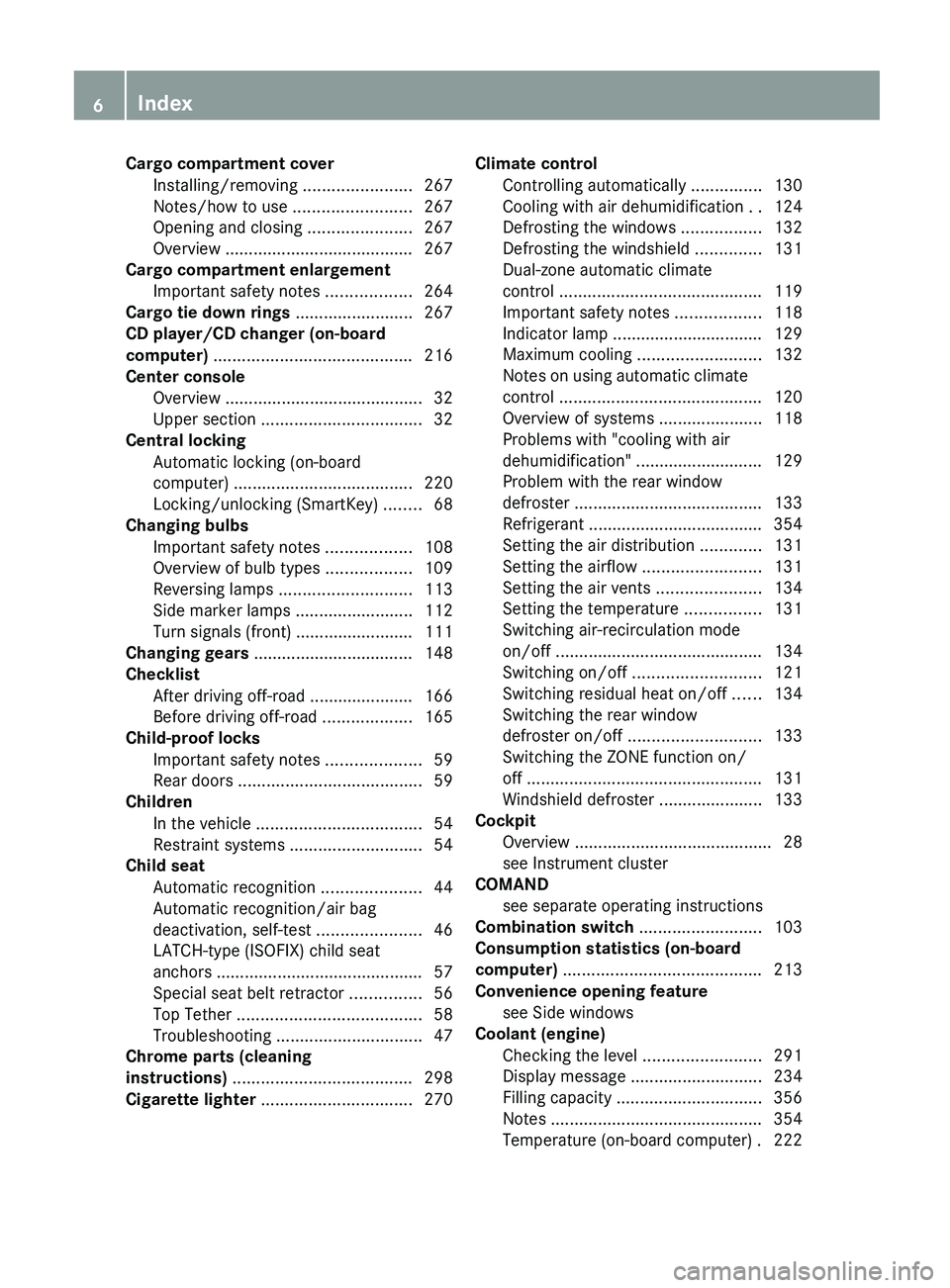
Cargo compartment cover
Installing/removing .......................267
Notes/how to use ......................... 267
Opening and closing ...................... 267
Overview ........................................ 267
Cargo compartment enlargement
Important safety notes .................. 264
Cargo tie down rings ......................... 267
CD player/CD changer (on-board
computer)
.......................................... 216
Center console Overview .......................................... 32
Upper section .................................. 32
Central locking
Automatic locking (on-board
computer) ...................................... 220
Locking/unlocking (SmartKey) ........ 68
Changing bulbs
Important safety notes .................. 108
Overview of bulb types ..................109
Reversing lamps ............................ 113
Side marker lamps .........................112
Turn signals (front) ......................... 111
Changing gears .................................. 148
Checklist After driving off-road ...................... 166
Before driving off-road ................... 165
Child-proof locks
Important safety notes .................... 59
Rear doors ....................................... 59
Children
In the vehicle ................................... 54
Restraint systems ............................ 54
Child seat
Automatic recognition ..................... 44
Automatic recognition/air bag
deactivation, self-test ......................46
LATCH-type (ISOFIX) child seat
anchors ............................................ 57
Special seat belt retractor ............... 56
Top Tether ....................................... 58
Troubleshooting ............................... 47
Chrome parts (cleaning
instructions) ...................................... 298
Cigarette lighter ................................ 270Climate control
Controlling automatically ............... 130
Cooling with air dehumidification ..124
Defrosting the windows ................. 132
Defrosting the windshield
..............131
Dual-zone automatic climate
control ........................................... 119
Important safety notes .................. 118
Indicator lamp ................................ 129
Maximum cooling .......................... 132
Notes on using automatic climate
control ........................................... 120
Overview of systems ...................... 118
Problems with "cooling with air
dehumidification" ........................... 129
Problem with the rear window
defroster ........................................ 133
Refrigerant ..................................... 354
Setting the air distribution .............131
Setting the airflow ......................... 131
Setting the air vents ......................134
Setting the temperature ................ 131
Switching air-recirculation mode
on/off ............................................ 134
Switching on/off ........................... 121
Switching residual heat on/off ...... 134
Switching the rear window
defroster on/off ............................ 133
Switching the ZONE function on/
off .................................................. 131
Windshield defroster ......................133
Cockpit
Overview .......................................... 28
see Instrument cluster
COMAND
see separate operating instructions
Combination switch ..........................103
Consumption statistics (on-board
computer) .......................................... 213
Convenience opening feature see Side windows
Coolant (engine)
Checking the level ......................... 291
Display message ............................ 234
Filling capacity ............................... 356
Notes ............................................. 354
Temperature (on-board computer) . 222 6
Index
Page 13 of 364

L
Lap time (RACETIMER) ......................222
LATCH-type (ISOFIX) child seat
anchors ................................................ 57
License plate lamp (display
message) ............................................ 233
Lights Activating/deactivating the
interior lighting delayed switch-off . 220
Automatic headlamp mode
............100
Cornering light function .................104
Driving abroad ................................. 98
Fog lamps ...................................... 101
Hazard warning lamps ................... 104
High beam flasher .......................... 104
High-beam headlamps ...................103
Light switch ..................................... 98
Low-beam headlamps ...................... 99
Parking lamps ................................ 102
Rear fog lamp ................................ 101
Standing lamps .............................. 102
Switching the daytime running
lamps on/off (on-board
computer) ...................................... 219
Switching the daytime running
lamps on/off (switch) ...................... 99
Switching the exterior lighting
delayed switch-off on/off (on-
board computer) ............................ 219
Switching the surround lighting
on/off (on-board computer) ..........219
Turn signals ................................... 103
see Changing bulbs
see Interior lighting
Light sensor (display message) .......234
LIM indicator lamp Cruise control ................................ 170
DISTRONIC PLUS ........................... 179
Variable SPEEDTRONIC .................175
Limit speed
Variable SPEEDTRONIC .................174
Load anchorage ................................. 266
Loading guidelines ............................262Locking
Emergency locking ........................... 76
From inside the vehicle (central
locking button) ................................. 74
see Central locking
Locking (doors)
Automatic ........................................ 75
Locking centrally
see Central locking
Locking verification signal (on-
board computer) ............................... 221
Low-beam headlamps Display message ............................ 231
Setting for driving abroad
(symmetrical) ................................... 98
Switching on/off .............................. 99
LOW RANGE off-road gear ................199
Luggage compartment
enlargement
Overview ........................................ 264
Lumbar support
Adjusting the 4-way lumbar
support ............................................ 89
Luxury head restraints .......................87 M
M+S tires ............................................ 320
Malfunction message see Display messages
Matte finish (cleaning
instructions) ...................................... 296
mbrace Call priority .................................... 276
Display message ............................ 229
Downloading destinations
(COMAND) ..................................... 277
Downloading routes .......................279
Emergency call .............................. 274
Geo fencing ................................... 280
Important safety notes .................. 272
Locating a stolen vehicle ............... 278
MB info call button ........................ 276
Remote vehicle locking .................. 277
Roadside Assistance button .......... 275
Self-test ......................................... 273
Speed alert .................................... 279
System .......................................... 273 Index
11
Page 16 of 364

Remote control
Programming (garage door
opener) .......................................... 281
Reporting safety defects .................... 24
Reserve (fuel tank) see Fuel
Reserve fuel
Display message ............................ 237
Warning lamp ................................. 256
see Fuel
Residual heat
Switching on/off ........................... 134
Restraint systems
see SRS (Supplemental Restraint
System)
Reversing lamps (display
message) ............................................ 233
Roadside Assistance (breakdown) ....22
Roof lining and carpets (cleaning
guidelines) ......................................... 300
Route (navigation) see Route guidance (navigation)
Route guidance (navigation) ............214S
Safety Children in the vehicle .....................54
Child restraint systems ....................54
Safety system
see Driving safety systems
Seat backrest
Folding back .................................. 265
Seat belts
Adjusting the height ......................... 52
Belt force limiters ............................ 53
Cleaning ......................................... 300
Correct usage .................................. 49
Emergency Tensioning Devices ........ 53
Fastening ......................................... 50
Fastening, front ............................... 51
Fastening in the rear, center ............51
Important safety guidelines .............48
Releasing ......................................... 52
Safety guidelines ............................. 40
Special seat belt retractor ............... 56
Warning lamp ................................. 248
Warning lamp (function) ................... 53 Seat heating
Indicator lamp (malfunction) ............ 90
Seats
Adjusting (electrically) .....................86
Adjusting the 4-way lumbar
support ............................................ 89
Adjusting the head restraint ............ 86
Cleaning the cover .........................299
Correct driver's seat position ...........
84
Important safety notes .................... 85
Overview .......................................... 85
Storing settings (memory
function) .......................................... 95
Switching seat heating on/off ......... 89
Switching seat ventilation on/off ....90
Seat ventilation
Indicator lamp (malfunction) ............ 90
Sensors (cleaning instructions) .......297
Service interval display Displaying a service message (on-
board computer) ............................ 293
Service menu (on-board computer) . 218
Service products Brake fluid ..................................... 354
Coolant (engine) ............................ 354
Engine oil ....................................... 353
Fuel ................................................ 350
Important safety notes .................. 350
Notes ............................................. 350
Refrigerant (air-conditioning
system) .......................................... 354
Washer fluid ................................... 356
Setting a speed limit
see SPEEDTRONIC
Settings
Calling up a stored setting ............... 96
Factory (on-board computer) ......... 222
On-board computer ....................... 218
Setting the air distribution ...............131
SETUP (on-board computer) ............. 222
Shift ranges ....................................... 150
Side marker lamp (display
message) ............................................ 233
Side marker lamps (changing
bulbs) ................................................. 11214
Index
Page 41 of 364

The restraint system consists of:
R
seat belts
R child restraint systems
R LATCH-type (ISOFIX) child seat anchors
Additional protection is provided by:
R SRS (Supplemental Restraint System)
R NECK-PRO head restraints
R Air bag system components with:
-The 00730074 indicator lamp
- Front-passenger seat with BabySmart™
air bag deactivation system
The different air bag systems work
independently of each other. The protective
functions of the system work in conjunction
with each other. Not all air bags are always
deployed in an accident.
i Observe the additional information on
infants and children traveling with you in
the vehicle and restraint systems for
infants and children (Y page 54). SRS (Supplemental Restraint System)
Introduction SRS reduces the risk of occupants coming
into contact with the vehicle's interior in the
event of an accident. It can also reduce the
effect of the forces to which occupants are
subjected during an accident.
SRS consists of:
R
The 0075 SRS warning lamp
R Air bags
R Air bag control unit (with crash sensors)
R Emergency Tensioning Device (ETD) for
seat belts
R Seat belt force limiter SRS warning lamp G
WARNING
The SRS self-check has detected a
malfunction if the 0075 SRS indicator lamp:
R does not light up at all
R does not go out after approximately four
seconds after the engine is started
R lights up after
the
engine is started or while
the vehicle is in motion
For your safety, Mercedes-Benz strongly
recommends that you have the system
checked as soon as possible at a qualified
specialist workshop. SRS may otherwise fail
to activate when it is needed in the event of
an accident, which could lead to serious or
fatal injuries. SRS might also be activated
unexpectedly and unnecessarily, which could
also result in injury.
In addition, work carried out improperly on
SRS may render SRS inoperative or cause
unintended air bag deployment. Work on the
SRS system should only be carried out by
qualified specialist personnel. Consult a
qualified specialist workshop.
If it is necessary to modify an air bag system
to accommodate a person with disabilities,
contact an authorized Mercedes-Benz Center
for details. USA only: for further information,
contact our Customer Assistance Center at
1-800-FOR-MERCedes (1-800-367-6372).
SRS functions are checked regularly when
you switch on the ignition and when the
engine is running. Therefore, malfunctions
can be detected in good time.
The 0075 SRS warning lamp in the instrument
cluster lights up when the ignition is switched
on. It goes out no later than a few seconds
after the engine is started.
The SRS components are in operational
readiness when the SRS 0075 indicator lamp
goes out while the engine is running. Occupant safety
39
Safety Z
Page 43 of 364
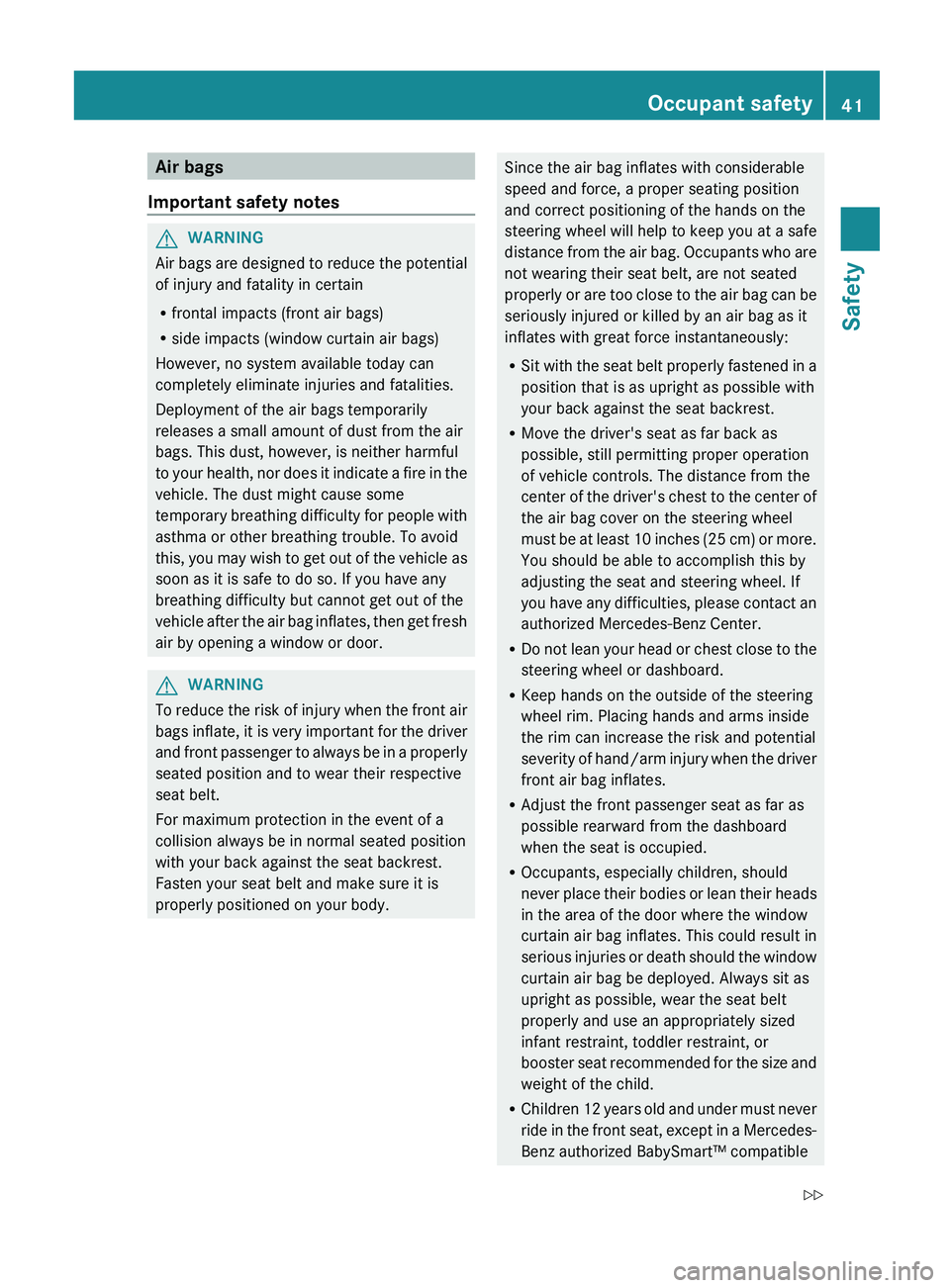
Air bags
Important safety notes G
WARNING
Air bags are designed to reduce the potential
of injury and fatality in certain
R frontal impacts (front air bags)
R side impacts (window curtain air bags)
However, no system available today can
completely eliminate injuries and fatalities.
Deployment of the air bags temporarily
releases a small amount of dust from the air
bags. This dust, however, is neither harmful
to your health, nor
does it indicate a fire in the
vehicle. The dust might cause some
temporary breathing difficulty for people with
asthma or other breathing trouble. To avoid
this, you may wish to get out of the vehicle as
soon as it is safe to do so. If you have any
breathing difficulty but cannot get out of the
vehicle after the air bag inflates, then get fresh
air by opening a window or door. G
WARNING
To reduce the risk of injury when the front air
bags inflate, it
is
very important for the driver
and front passenger to always be in a properly
seated position and to wear their respective
seat belt.
For maximum protection in the event of a
collision always be in normal seated position
with your back against the seat backrest.
Fasten your seat belt and make sure it is
properly positioned on your body. Since the air bag inflates with considerable
speed and force, a proper seating position
and correct positioning of the hands on the
steering wheel will
help
to keep you at a safe
distance from the air bag. Occupants who are
not wearing their seat belt, are not seated
properly or are too close to the air bag can be
seriously injured or killed by an air bag as it
inflates with great force instantaneously:
R Sit with the seat belt properly fastened in a
position that is as upright as possible with
your back against the seat backrest.
R Move the driver's seat as far back as
possible, still permitting proper operation
of vehicle controls. The distance from the
center of the driver's chest to the center of
the air bag cover on the steering wheel
must be at least 10 inches (25 cm) or more.
You should be able to accomplish this by
adjusting the seat and steering wheel. If
you have any difficulties, please contact an
authorized Mercedes-Benz Center.
R Do not lean your head or chest close to the
steering wheel or dashboard.
R Keep hands on the outside of the steering
wheel rim. Placing hands and arms inside
the rim can increase the risk and potential
severity of hand/arm injury when the driver
front air bag inflates.
R Adjust the front passenger seat as far as
possible rearward from the dashboard
when the seat is occupied.
R Occupants, especially children, should
never place their bodies or lean their heads
in the area of the door where the window
curtain air bag inflates. This could result in
serious injuries or death should the window
curtain air bag be deployed. Always sit as
upright as possible, wear the seat belt
properly and use an appropriately sized
infant restraint, toddler restraint, or
booster seat recommended for the size and
weight of the child.
R Children 12 years old and under must never
ride in the front seat, except in a Mercedes-
Benz authorized BabySmart™ compatible Occupant safety
41
Safety
Z
Page 44 of 364
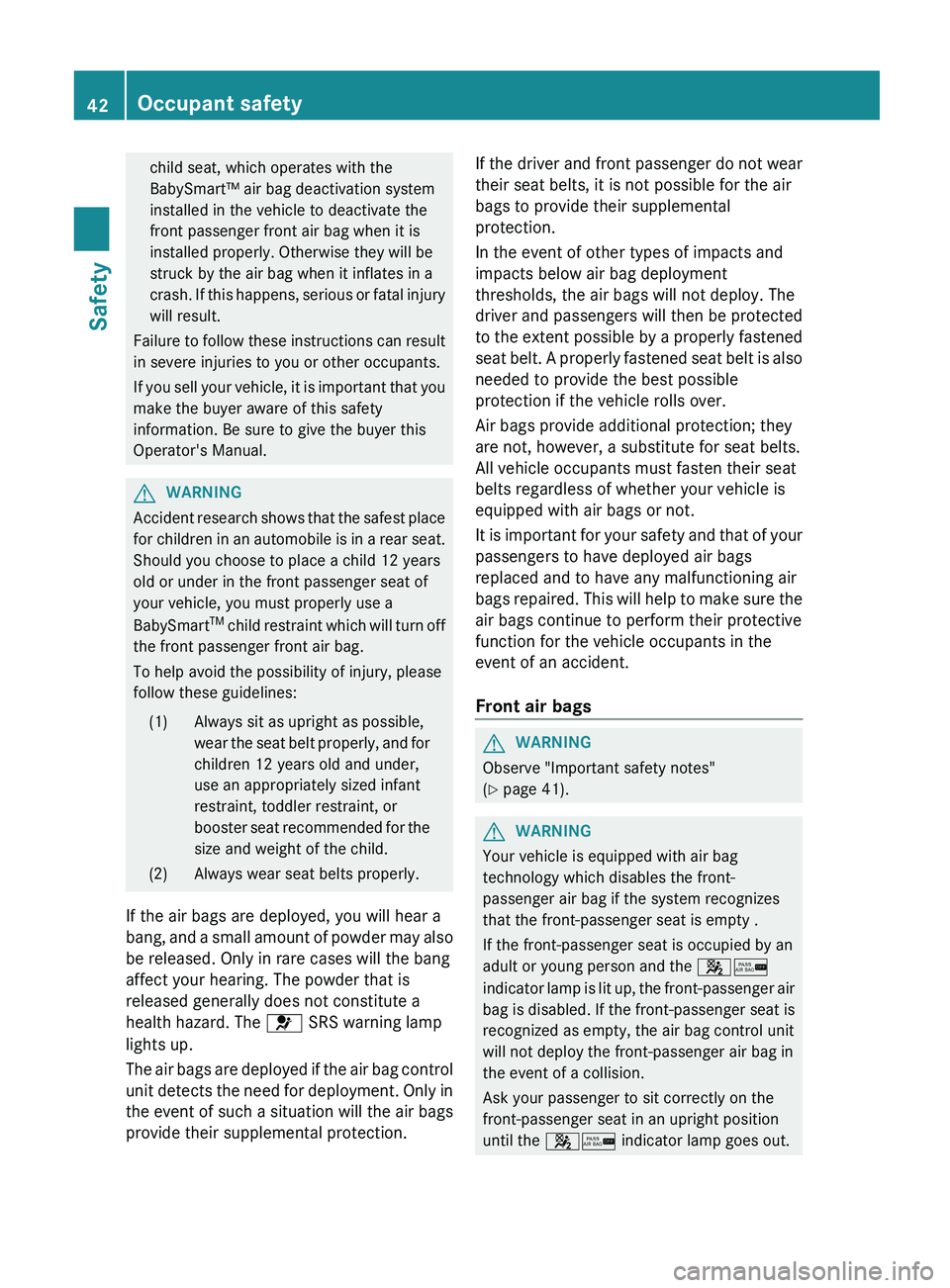
child seat, which operates with the
BabySmart™ air bag deactivation system
installed in the vehicle to deactivate the
front passenger front air bag when it is
installed properly. Otherwise they will be
struck by the air bag when it inflates in a
crash. If this
happens,
serious or fatal injury
will result.
Failure to follow these instructions can result
in severe injuries to you or other occupants.
If you sell your vehicle, it is important that you
make the buyer aware of this safety
information. Be sure to give the buyer this
Operator's Manual. G
WARNING
Accident research shows that the safest place
for children in an
automobile is in a rear seat.
Should you choose to place a child 12 years
old or under in the front passenger seat of
your vehicle, you must properly use a
BabySmart TM
child restraint which will turn off
the front passenger front air bag.
To help avoid the possibility of injury, please
follow these guidelines:
(1) Always sit as upright as possible, wear the seat belt
properly, and for
children 12 years old and under,
use an appropriately sized infant
restraint, toddler restraint, or
booster seat recommended for the
size and weight of the child.
(2) Always wear seat belts properly.
If the air bags are deployed, you will hear a
bang, and a small
amount of powder may also
be released. Only in rare cases will the bang
affect your hearing. The powder that is
released generally does not constitute a
health hazard. The 0075 SRS warning lamp
lights up.
The air bags are deployed if the air bag control
unit detects the need for deployment. Only in
the event of such a situation will the air bags
provide their supplemental protection. If the driver and front passenger do not wear
their seat belts, it is not possible for the air
bags to provide their supplemental
protection.
In the event of other types of impacts and
impacts below air bag deployment
thresholds, the air bags will not deploy. The
driver and passengers will then be protected
to the extent
possible
by a properly fastened
seat belt. A properly fastened seat belt is also
needed to provide the best possible
protection if the vehicle rolls over.
Air bags provide additional protection; they
are not, however, a substitute for seat belts.
All vehicle occupants must fasten their seat
belts regardless of whether your vehicle is
equipped with air bags or not.
It is important for your safety and that of your
passengers to have deployed air bags
replaced and to have any malfunctioning air
bags repaired. This will help to make sure the
air bags continue to perform their protective
function for the vehicle occupants in the
event of an accident.
Front air bags G
WARNING
Observe "Important safety notes"
(Y page 41). G
WARNING
Your vehicle is equipped with air bag
technology which disables the front-
passenger air bag if the system recognizes
that the front-passenger seat is empty .
If the front-passenger seat is occupied by an
adult or young person and the 0073007C
indicator lamp is lit
up, the front-passenger air
bag is disabled. If the front-passenger seat is
recognized as empty, the air bag control unit
will not deploy the front-passenger air bag in
the event of a collision.
Ask your passenger to sit correctly on the
front-passenger seat in an upright position
until the 0073007C indicator lamp goes out. 42
Occupant safety
Safety
Page 46 of 364
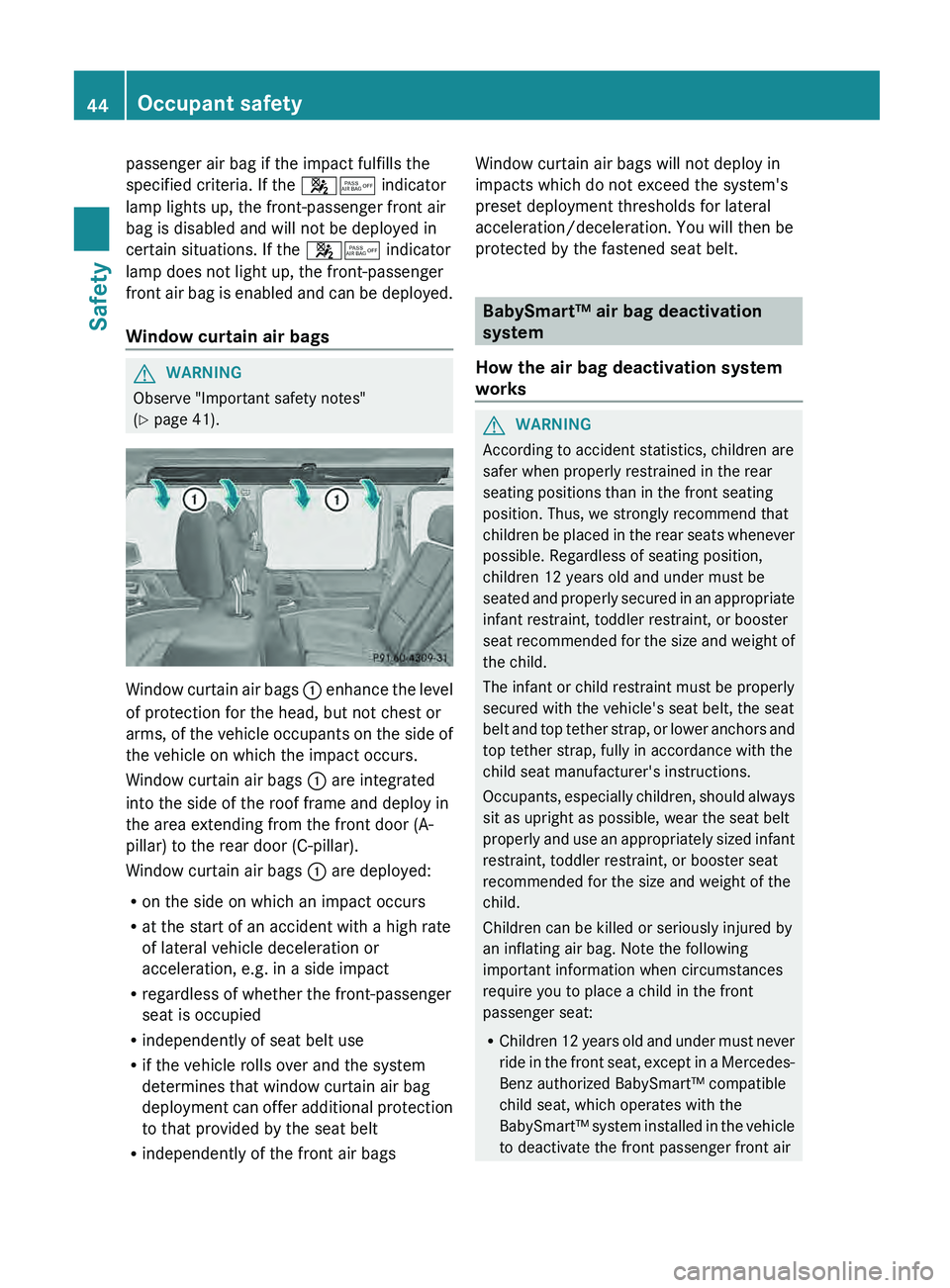
passenger air bag if the impact fulfills the
specified criteria. If the 00730074 indicator
lamp lights up, the front-passenger front air
bag is disabled and will not be deployed in
certain situations. If the
00730074 indicator
lamp does not light up, the front-passenger
front air bag is
enabled and can be deployed.
Window curtain air bags G
WARNING
Observe "Important safety notes"
(Y page 41). Window curtain air bags
0043
enhance the
level
of protection for the head, but not chest or
arms,
of the vehicle occupants on the side of
the vehicle on which the impact occurs.
Window curtain air bags 0043 are integrated
into the side of the roof frame and deploy in
the area extending from the front door (A-
pillar) to the rear door (C-pillar).
Window curtain air bags 0043 are deployed:
R on the side on which an impact occurs
R at the start of an accident with a high rate
of lateral vehicle deceleration or
acceleration, e.g. in a side impact
R regardless of whether the front-passenger
seat is occupied
R independently of seat belt use
R if the vehicle rolls over and the system
determines that window curtain air bag
deployment can offer additional protection
to that provided by the seat belt
R independently of the front air bags Window curtain air bags will not deploy in
impacts which do not exceed the system's
preset deployment thresholds for lateral
acceleration/deceleration. You will then be
protected by the fastened seat belt.
BabySmart™ air bag deactivation
system
How the air bag deactivation system
works G
WARNING
According to accident statistics, children are
safer when properly restrained in the rear
seating positions than in the front seating
position. Thus, we strongly recommend that
children be placed in
the rear seats whenever
possible. Regardless of seating position,
children 12 years old and under must be
seated and properly secured in an appropriate
infant restraint, toddler restraint, or booster
seat recommended for the size and weight of
the child.
The infant or child restraint must be properly
secured with the vehicle's seat belt, the seat
belt and top tether strap, or lower anchors and
top tether strap, fully in accordance with the
child seat manufacturer's instructions.
Occupants, especially children, should always
sit as upright as possible, wear the seat belt
properly and use an appropriately sized infant
restraint, toddler restraint, or booster seat
recommended for the size and weight of the
child.
Children can be killed or seriously injured by
an inflating air bag. Note the following
important information when circumstances
require you to place a child in the front
passenger seat:
R Children 12 years old and under must never
ride in the front seat, except in a Mercedes-
Benz authorized BabySmart™ compatible
child seat, which operates with the
BabySmart™ system installed in the vehicle
to deactivate the front passenger front air44
Occupant safety
Safety
Page 47 of 364
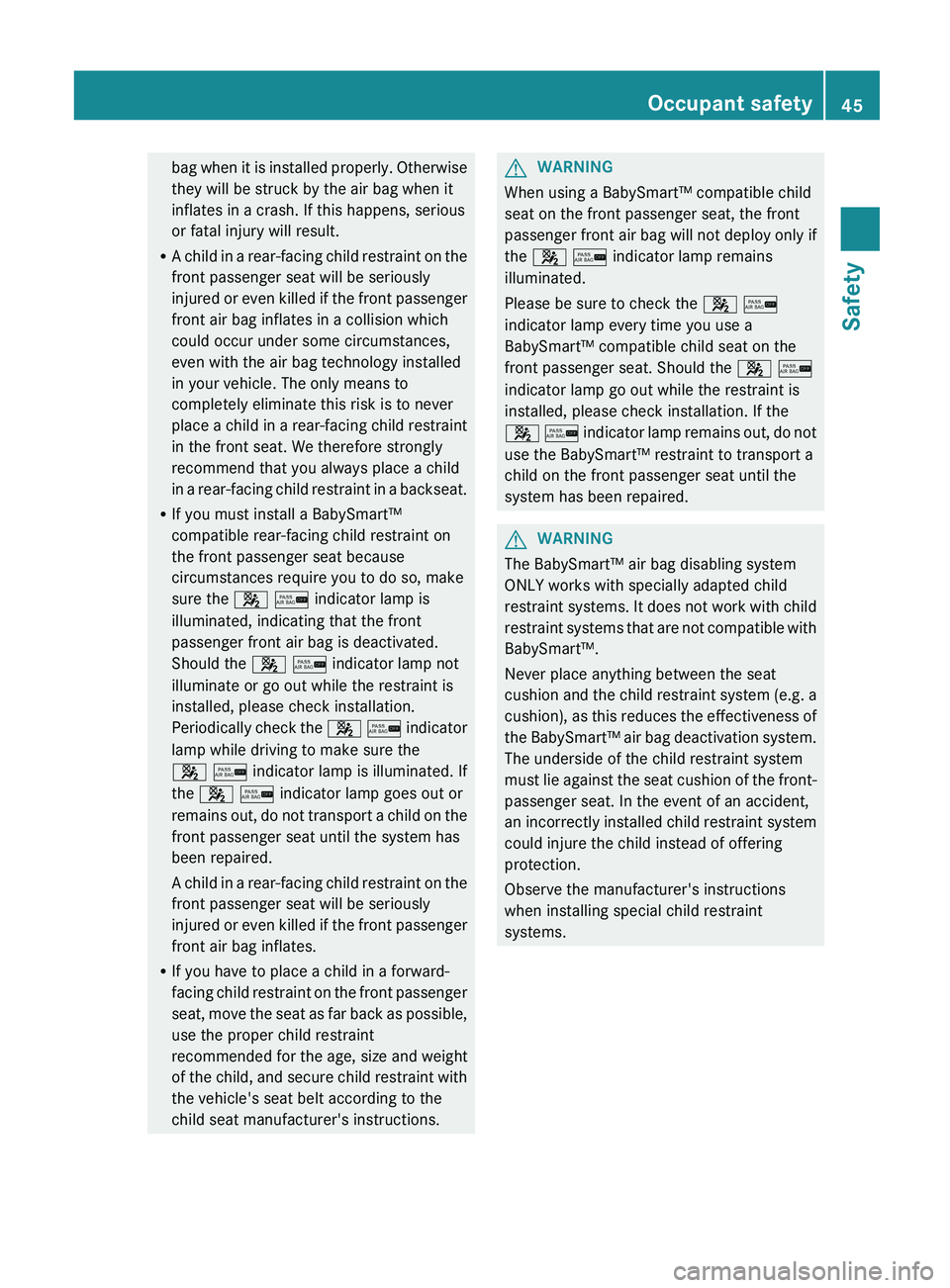
bag when it is installed properly. Otherwise
they will be struck by the air bag when it
inflates in a crash. If this happens, serious
or fatal injury will result.
R A child in a
rear-facing child restraint on the
front passenger seat will be seriously
injured or even killed if the front passenger
front air bag inflates in a collision which
could occur under some circumstances,
even with the air bag technology installed
in your vehicle. The only means to
completely eliminate this risk is to never
place a child in a rear-facing child restraint
in the front seat. We therefore strongly
recommend that you always place a child
in a rear-facing child restraint in a backseat.
R If you must install a BabySmart™
compatible rear-facing child restraint on
the front passenger seat because
circumstances require you to do so, make
sure the 0073 007C indicator lamp is
illuminated, indicating that the front
passenger front air bag is deactivated.
Should the 0073 007C indicator lamp not
illuminate or go out while the restraint is
installed, please check installation.
Periodically check the 0073 007C indicator
lamp while driving to make sure the
0073 007C indicator lamp is illuminated. If
the 0073 007C indicator lamp goes out or
remains out, do not transport a child on the
front passenger seat until the system has
been repaired.
A child in a rear-facing child restraint on the
front passenger seat will be seriously
injured or even killed if the front passenger
front air bag inflates.
R If you have to place a child in a forward-
facing child restraint on the front passenger
seat, move the seat as far back as possible,
use the proper child restraint
recommended for the age, size and weight
of the child, and secure child restraint with
the vehicle's seat belt according to the
child seat manufacturer's instructions. G
WARNING
When using a BabySmart™ compatible child
seat on the front passenger seat, the front
passenger front air bag
will not deploy only if
the 0073 007C indicator lamp remains
illuminated.
Please be sure to check the 0073 007C
indicator lamp every time you use a
BabySmart™ compatible child seat on the
front passenger seat. Should the 0073 007C
indicator lamp go out while the restraint is
installed, please check installation. If the
0073 007C indicator lamp remains out, do not
use the BabySmart™ restraint to transport a
child on the front passenger seat until the
system has been repaired. G
WARNING
The BabySmart™ air bag disabling system
ONLY works with specially adapted child
restraint systems. It does
not work with child
restraint systems that are not compatible with
BabySmart™.
Never place anything between the seat
cushion and the child restraint system (e.g. a
cushion), as this reduces the effectiveness of
the BabySmart™ air bag deactivation system.
The underside of the child restraint system
must lie against the seat cushion of the front-
passenger seat. In the event of an accident,
an incorrectly installed child restraint system
could injure the child instead of offering
protection.
Observe the manufacturer's instructions
when installing special child restraint
systems. Occupant safety
45
Safety Z